1954 Corvette Overview – The Ultimate Guide
The 1954 Corvette began production in December, 1953. Although the first fourteen or fifteen ‘54 Corvettes were built in Flint, Michigan (like all of the 1953 Corvettes) GM shifted Corvette’s production to a newly renovated assembly plant in St Louis, Missouri. This plant was designed to produce more than 10,000 Corvettes a year.
There were very few initial design changes between the 1953 and 1954 model Corvettes, although refinements would be made throughout the 1954 production year. For example, the 1953 Corvette had two short stainless-steel exhaust outlets protruding inboard of the rear fenders.
This design resulted in exhaust gases being sucked back against the rear end of the car, thereby staining the paint. As a result, the 1954 model had longer outlets that were run below the car’s body. Other changes included relocating the fuel and brake lines inboard of the right-hand main frame rail, providing them with additional protection. Also, the canvas tops and rails were changed from black to tan.
Some of the inconveniences of the 1953 model were also corrected in 1954. The original two-handle exterior hood latch was replaced by a single handle mechanism after the production of the first 300 (approximate) 1954 models. The choke control was moved from the right to the left of the steering column. This eliminated having to reach over or through the steering wheel to operate the choke control with the left hand while simultaneously attempting to turn the ignition key with the right.
Under the hood, some additional changes were also made to the engine and drivetrain. For one, the use of a new camshaft increased the total horsepower of the “Blue Flame” six cylinder to 155bhp (as compared to the 150bhp of the 1953).
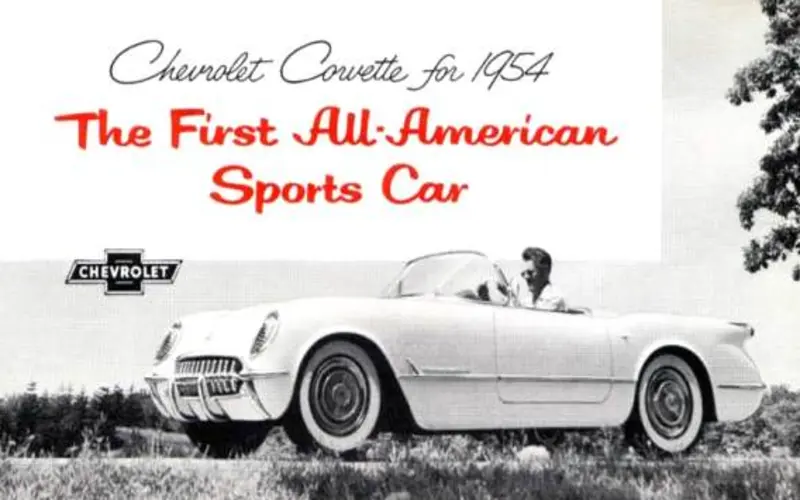
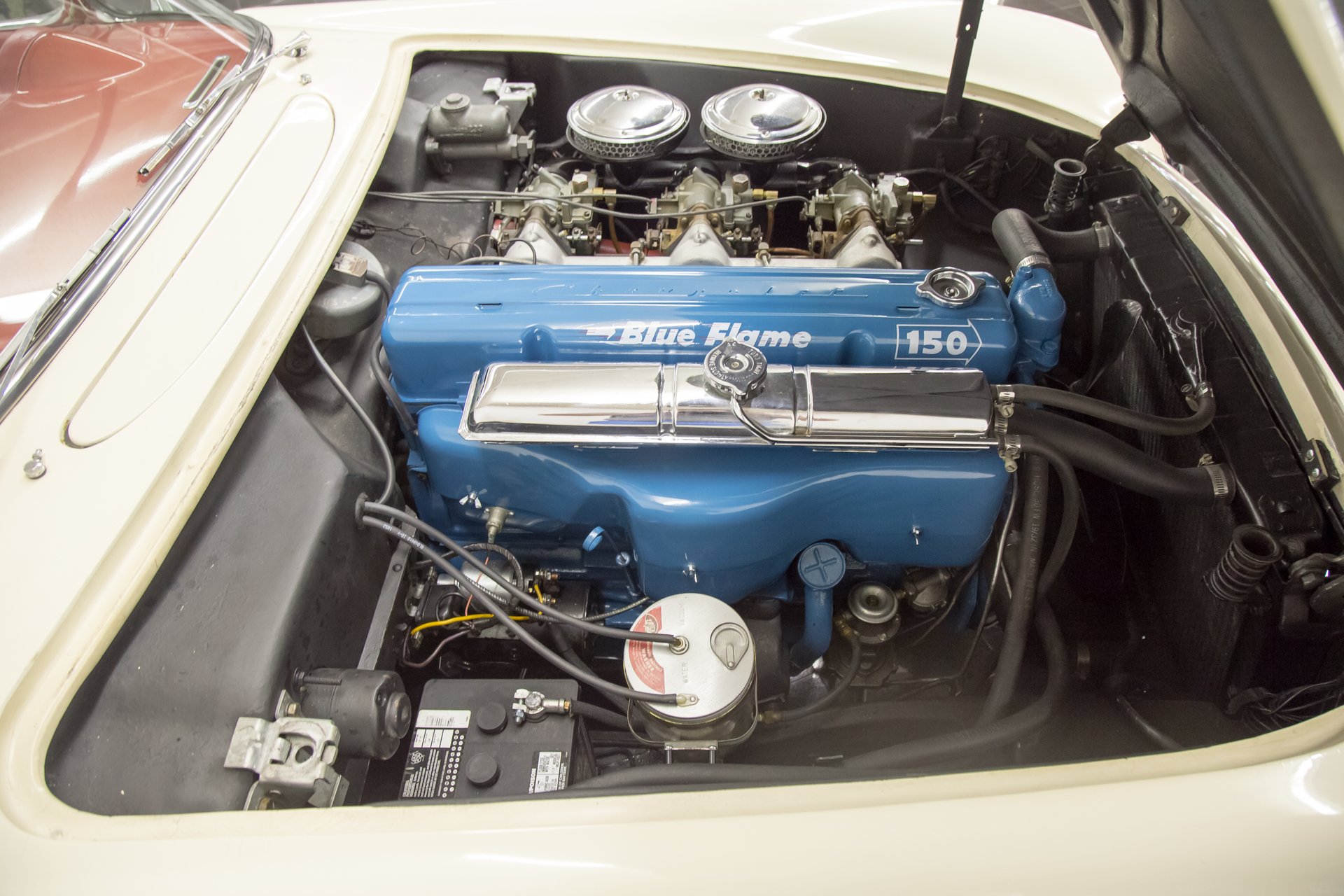
Other alterations included a new-style rocker arm (valve) cover (of which approximately 20% were finished in chrome – serial numbers 1363 through 4381 and of which all were now held down by four bolts through the outer lip of the cover instead of two center studs), a better designed wiring harness, dual air filters, a new type of starter and plastic insulated wire (instead of fabric insulated).
Perhaps the most notable change from the 1953 to 1954 models was the opportunity to purchase a Corvette with a choice of different color options. In 1954, General Motors offered the Corvette to consumers with the following color combinations:
Pennant Blue with a Tan interior (which accounted for 16% of the production models made that year), Sportsman Red with a Red Interior (which accounted for a mere 4% of the production models), Polo White with a Red Interior (which accounted for about 80% of the production models).
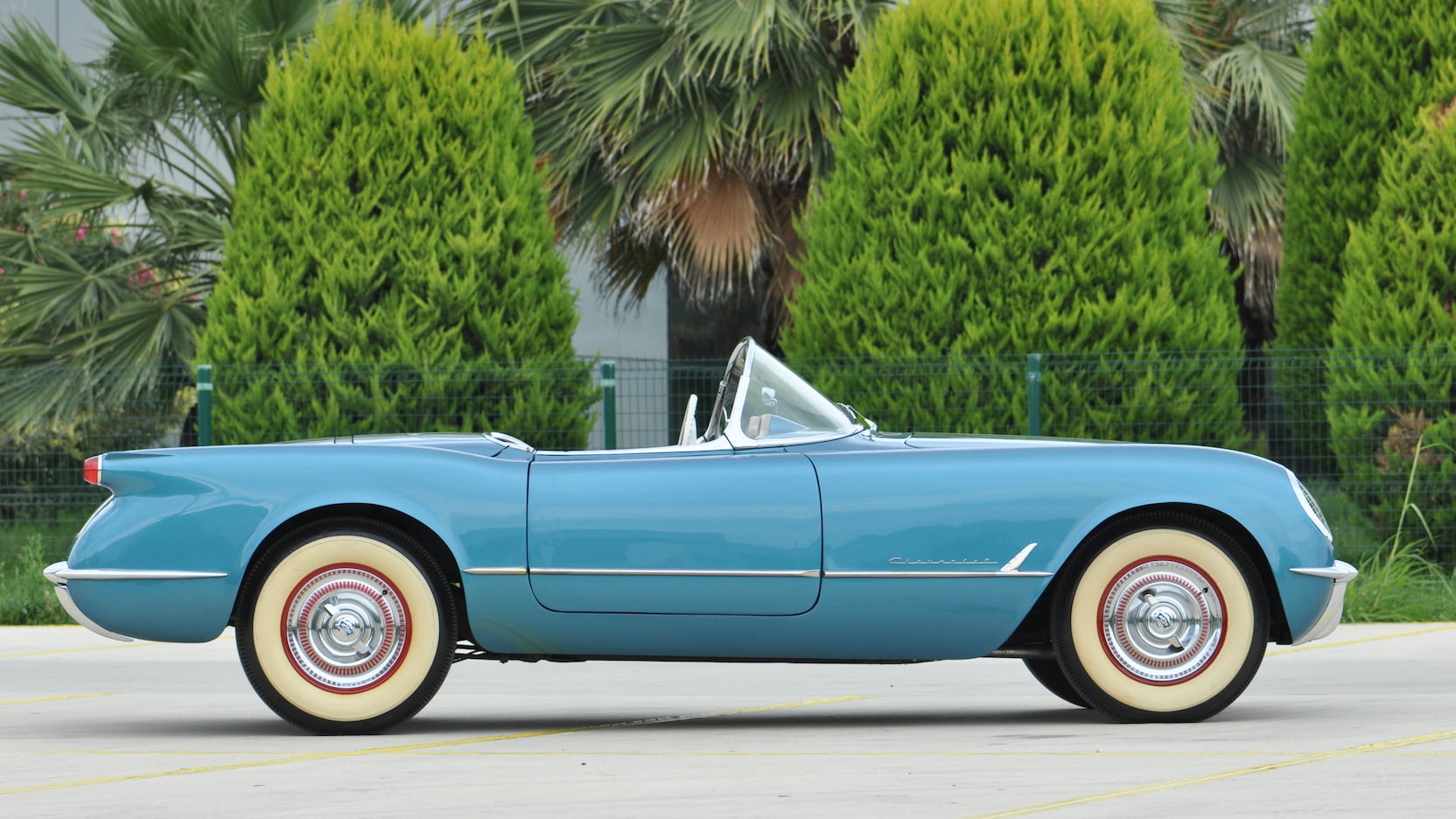
A fourth color combination – Black with Red Interior – accounted for as few as six of the production models from that year.
Some ‘54 Corvette owners have claimed that they have factory paint on their vehicles that is different from the four choices listed above, although no factory records exist to verify this claim. Still, paint bulletins from that period are known to have listed a Metallic Green and a Metallic Bronze as well.
While Corvette was finally available for purchase by anyone who wanted one, the car was priced in such a way that many potential “younger” buyers were scared off by the price.
With a window sticker price of $3498.00, the car was considered too expensive for the youthful market at which the Corvette marketing was aimed. In an attempt to make the car appear more price competitive, Chevy lowered the advertised base price to $2774 (which was still more than the price of a Cadillac with a standard V-8 engine) for the 1954 models.
DID YOU KNOW: In an attempt to make the purchase price more palatable to consumers, GM introduced the 1954 Corvette to the public as a base model that could be tailored to the needs and personal wants of consumers worldwide. One such option was the transmission: Although the two speed Powerglide transmission was listed as a $178 option, no other transmissions were available for the 1954 Corvette, making the “optional” transmission a necessity if you wanted an operational car.
However, potential customers were shocked to learn that the only available transmission for the Corvette (the 2 speed Powerglide) was listed as an option, as were the windshield wipers and the heater. Truth be told, the actual price for the 1954 Corvette was $3254.10. Most consumers saw through this marketing trickery and sales of the 1954 Corvette suffered as a result of it.
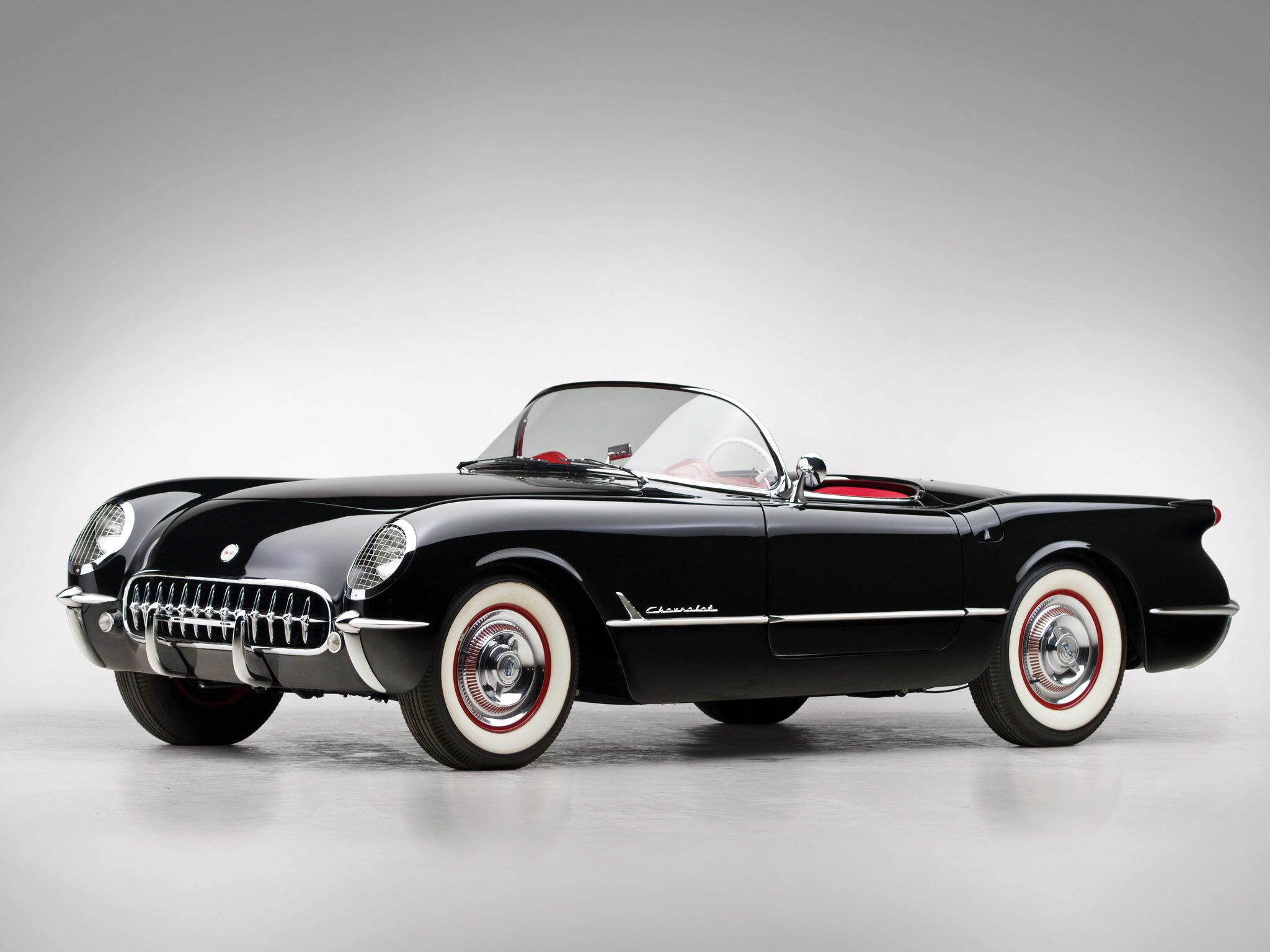
One of the best selling points of the 1954 Corvette was its reliability. It wasn’t prone to breaking down and it did not demand constant tuning and attention to keep running reliably. As with the 1953 Corvette before it, the 1954 did have a few quirks: the synchronizing of the triple carburetors for smooth idle and throttle response was tricky (to down-right difficult) to accomplish.
Also like the 1953, water leaks continued to be a problem, although mostly from the top and the side window curtains. None of these items were considered major issues. Besides, General Motors released service bulletins to cover them, ensuring that any issues that did arise were properly addressed and repaired.
At the same time, one of the biggest on-going issues that faced the 1954 Corvette had nothing to do with the mechanical, structural or cosmetic short-comings of the car itself – at least not directly. The bigger issue was an indirect combination of all these items and the general public perception of the car as a whole.
Simply put, Corvette was not a pure “sports car”. Some considered it a boulevard tourer that lacked the performance and handling of a true, out-and-out roadster. Purists sneered at the automatic 2-speed Powerglide transmission and the limited performance of the “Blue Flame” six-cylinder engine (especially when comparable cars (like the Jaguar XK-120) offered a V-8 and a 4-speed manual transmission for less money).
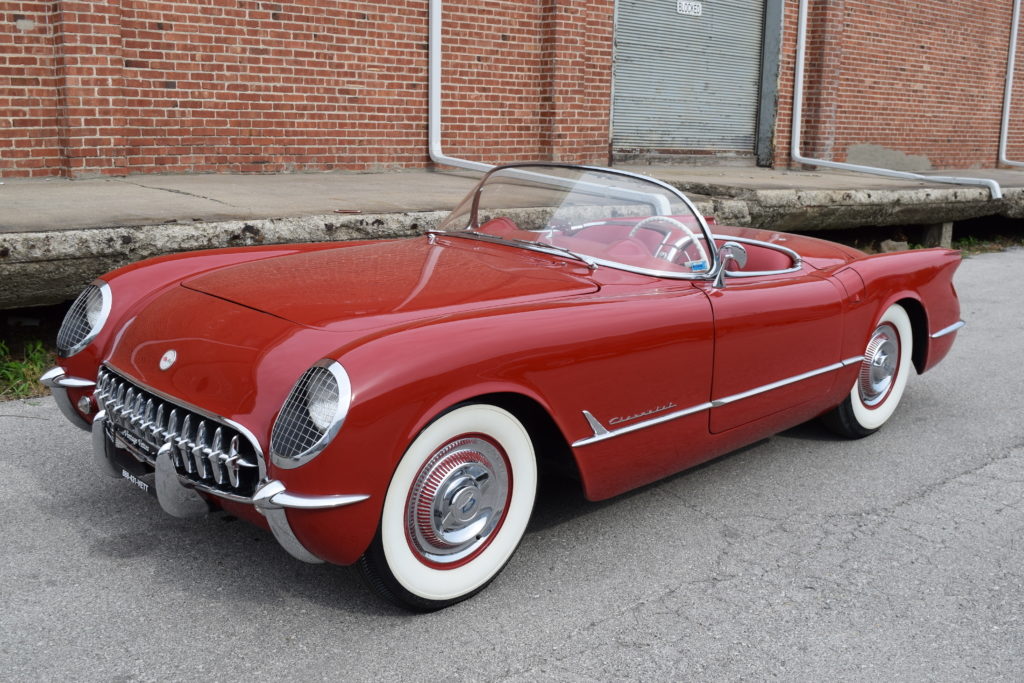
Cosmetic issues, such as the car’s dummy knock-off wheel covers, manual folding top, and a re-circulating heater that didn’t allow for windows-up ventilation also generated criticism of the car and were all likely contributed to the overall lack of Corvette sales.
Production Numbers
While Chevrolet had hoped that Corvette’s production would be as many as 1,000 units per month, the actual number built for the model year was only 3,640 – less than a third of the projected total – and at year’s end the division found itself with a surplus of 1500 cars still sitting, unsold, in dealerships across the country.
Despite the initial, overwhelmingly positive response to the Corvette at the 1953 Motorama, it was becoming clear that Chevrolet’s sports car experiment was a failure. It wasn’t long before the rumors began circulating the Corvette was on the verge of extinction as corporate management argued about the car’s commercial viability.
1954 Corvette Specifications & Performance
See the complete breakdown of technical specifications for the 1954 Corvette, including engine, suspension, brakes, body dimensions, and power.
Read more: 1954 Corvette Specifications.
Engine & Transmission
When introduced in 1953, the Corvette featured the “Blue Flame” six cylinder engine. This is not as the Chevrolet engineering team wanted things, but they had no choice. Although other GM marques featured V8 motors they were not willing to share; a very different situation compared to years later when various divisions would feature the same powerplants. It was renowned for reliability but with a rating of 105 horsepower, performance and sportiness were not included.
The engineering staff responded with the usual engine upgrade methods. A more radical camshaft rubbing on solid lifters, dual valve springs, and a higher compression ratio cylinder head (8.0:1; previous was 7.5:1) all contributed to the effort. The largest gain was achieved via an upgrade to the induction system (right). Three Carter type YH side draft carburetors featuring “bullet” air cleaners with an aluminum manifold were incorporated and the output soared to 150 bhp at 4,500 RPM.
Chevrolet upgraded the Blue Flame Six for Corvette duty with a higher compression ratio, dual exhausts, triple carburetors, and a hotter camshaft. And Chevy upgraded the camshaft again midway through 1954. However, though 155 hp was decent for an inline-six in 1954, the engine itself was from a Chevrolet Bel Air. Not exactly the best origin story for what’s supposed to be an ‘exotic’ sports car.
Performance
The 1954 Corvette was once again just an average performer, with a 0 – 60 mph time of just 11.2 seconds and a quarter mile time of 17.9 seconds @ 77mph. Top speed for the 1964 Corvette was 108 mph. Thankfully, Chevrolet did something about performance in subsequent years.
See complete 1954 Corvette specifications & performance.
1954 Corvette Vehicle Identification Numbers (VIN)
Read more: 1954 Corvette VIN details.
1954 Corvette Price & Options
Core Features & Factory Options
While the 1954 Corvettes were very similar to the 1953 models, it was clear that Chevy was continually working to improve the first sports car General Motors had ever produced. In 1954, gas and brake lines were improved throughout the model year, as were the awkward two handle exterior hood latch that was changed to a single-handle system. Additionally, the choke control was moved to a more convenient position and the rear license plate cover was altered so it would not fog up as easily. But other than these minor changes and the new color options, the cars remained the same as the initial offering of the Corvette, which was in turn almost identical to the concept car that had first appeared in January 1953 at GM’s Motorama at the New York Auto Show.
Still under every Corvette hood was the Blue Flame Special engine, which was a modified version of the 235 CID inline six-cylinder used in many Chevy cars at the time. A two-speed Powerglide automatic was still the only transmission available for the car, which frustrated some owners.
Other than the colors and modifications that Chevy made, all Corvettes produced in 1954 were exactly the same – even though options were listed (such as the Powerglide transmission), they were all mandatory and weren’t actually options. In addition to the new exterior colors, the new Blue cars came with a tan interior instead of the Sportsman Red that was the only option the previous year. It has been reported that as few as six Corvettes came with the black exterior.
Colors
The 1954 Corvette came in four color choices: Poloe white, Sportsman Red, Pennant Blue, and Black. The split in terms of production was Polo White (3,230), Sportsman Red (100), Pennant Blue (300) and Black (4). Interior colors include Beige Vinyl and Red Vinyl.
Pricing
The asking price for a 1954 Corvette was also an issue. It cost $2,774.00 without options (a price drop of $724 versus the 1953 model), still more than a Cadillac which featured a V8 engine and a top that did not leak. On the sports car side there was the Jaguar which also cost less than the Corvette AND featured a sophisticated, more powerful engine along with a genuine four speed transmission.
| CODE | DESCRIPTION | QUANTITY | RETAIL PRICE |
| 2934 | Base Corvette Roadster | 3,640 | $2,774.00 |
| 100 | Directional Signal | 3,640 | $16.75 |
| 101A | Heater | 3,640 | $91.40 |
| 102A | AM Radio, signal seeking | 3,640 | $145.15 |
| 290B | Whitewall Tires, 6.70 x 15 | 3,640 | $26.90 |
| 313M | Powerglide Automatic Transmission | 3,640 | $178.35 |
| 420A | Parking Brake Alarm | 3,640 | $5.65 |
| 421A | Courtesy Lights | 3,640 | $4.05 |
| 422A | Windshield Washer | 3,640 | $11.85 |
Read more: 1954 Corvette pricing and factory options.
1954 Corvette Gallery
Chevrolet attempted to widen the appeal of the Corvette with new colors including Pennant Blue (left) and Guardsman Red although the majority were still Polo White. A few Black cars were also built. All of the soft tops were beige and the Pennant Blue offered a beige interior. The other interiors were red. In the middle of the 1954 model a more aggressive camshaft boosted the horsepower from 150 hp to 155 hp.
See full 1954 Corvette Gallery


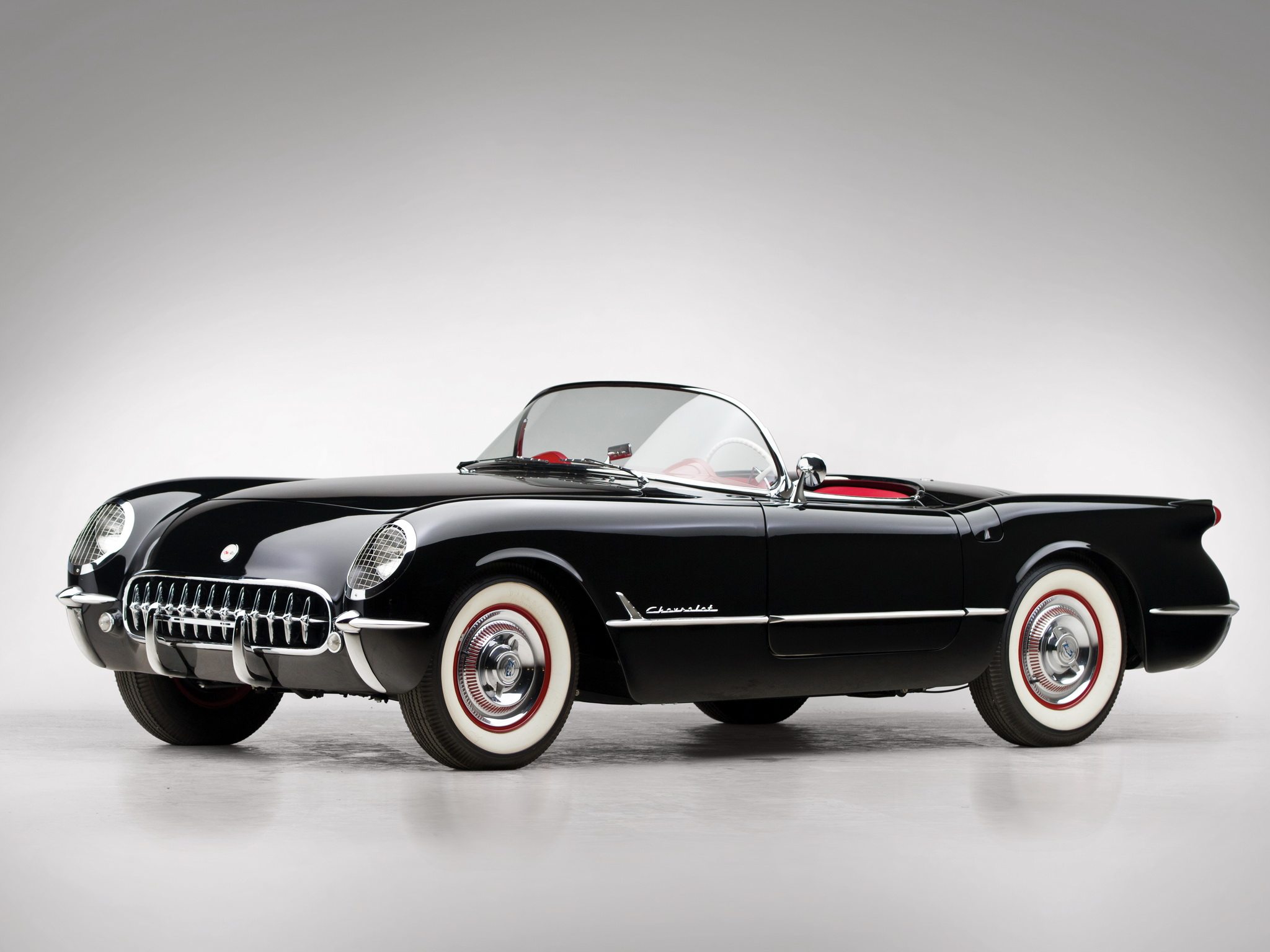
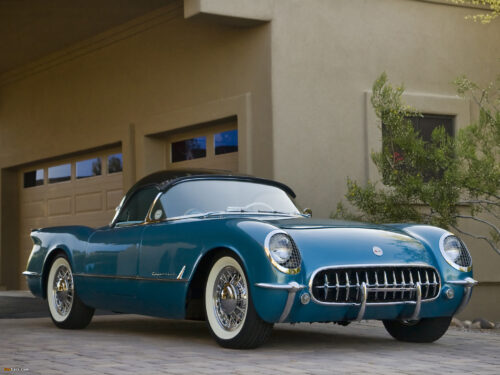
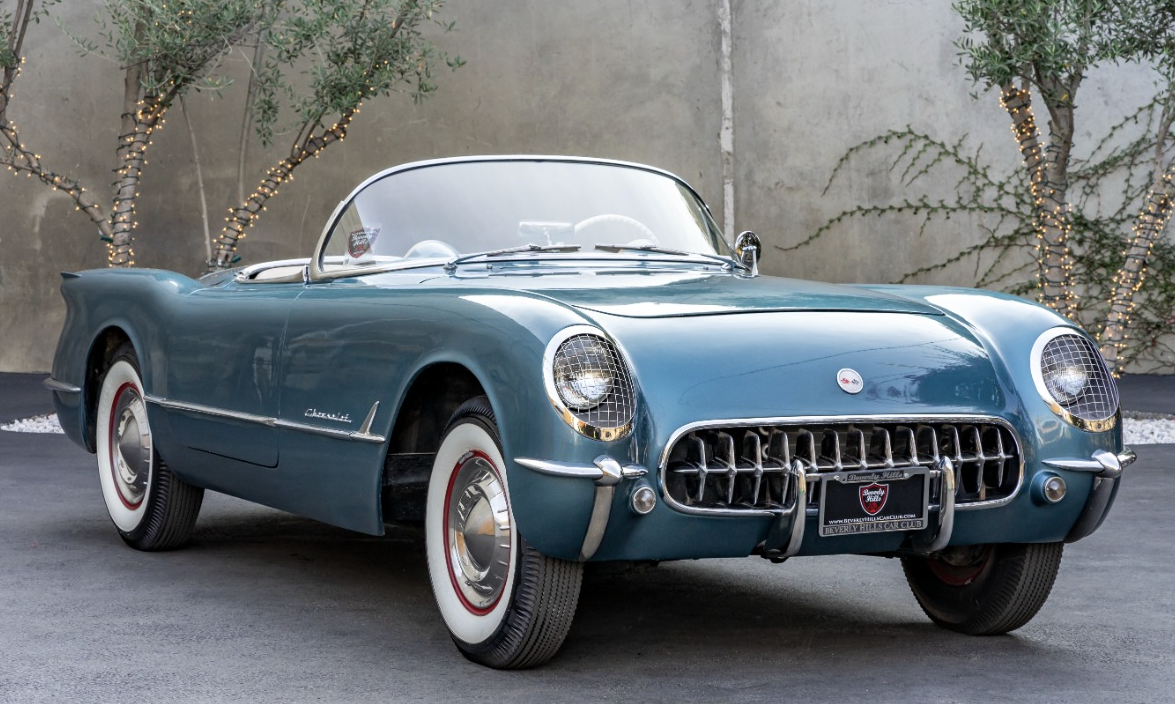
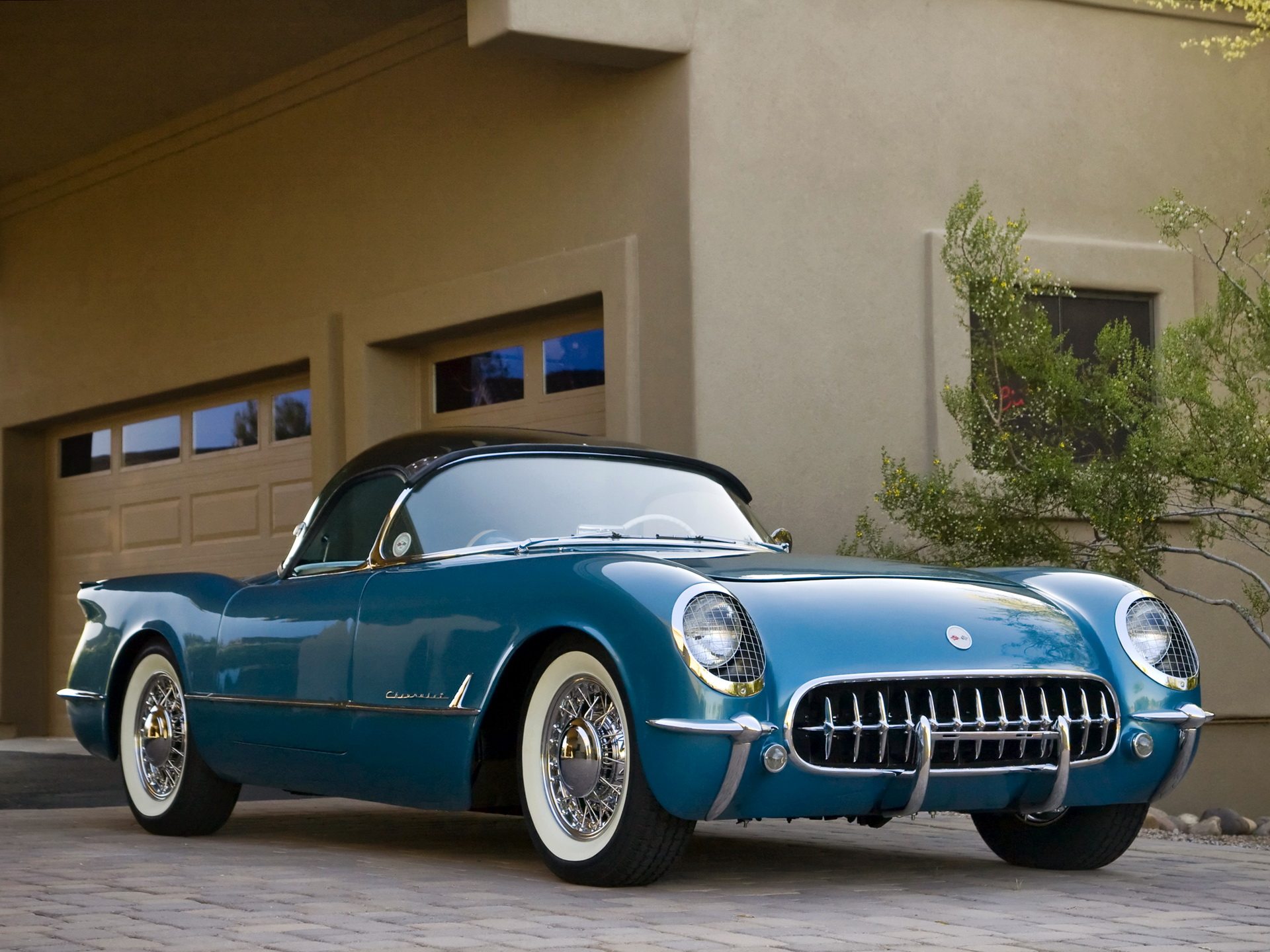
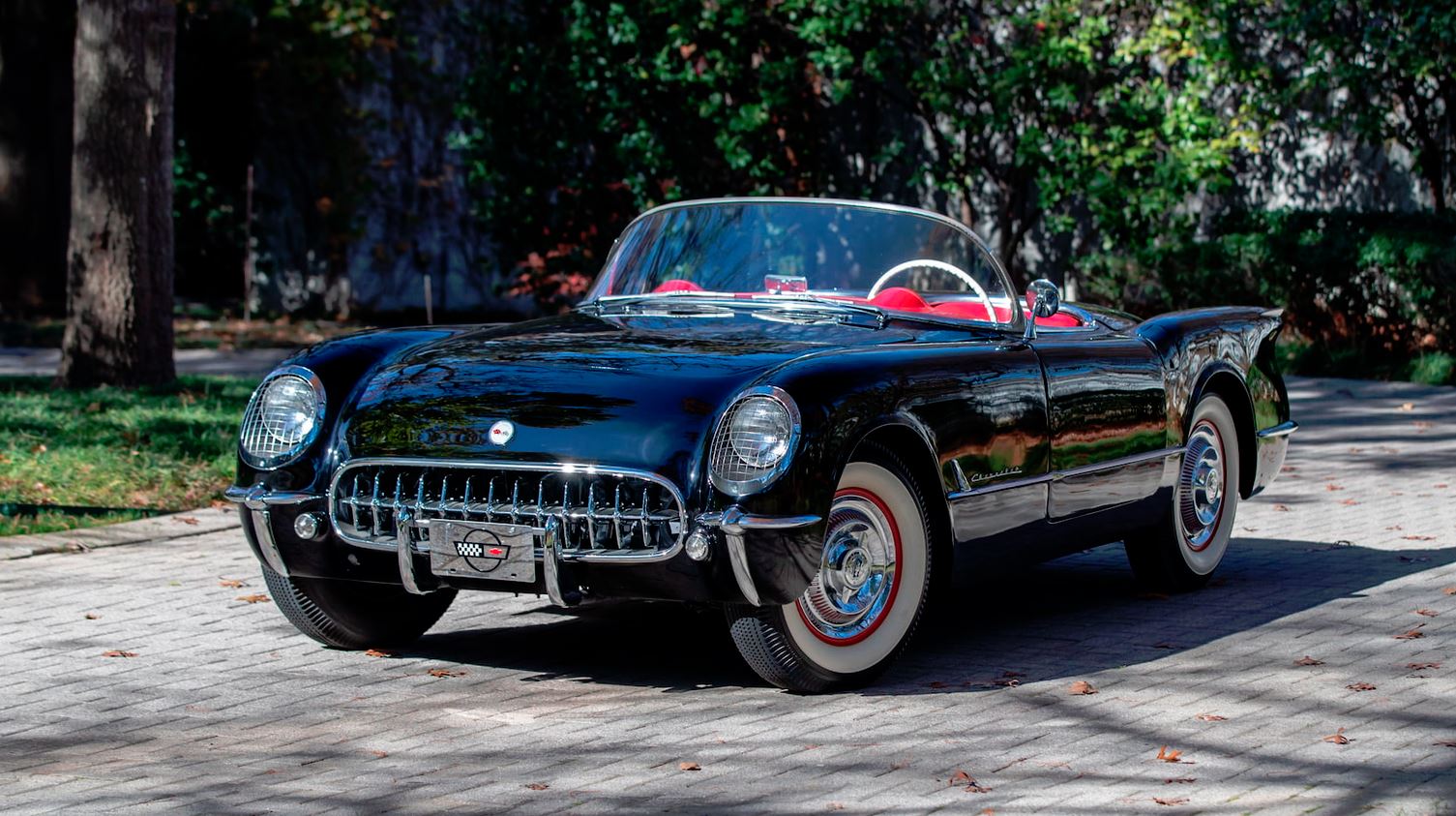
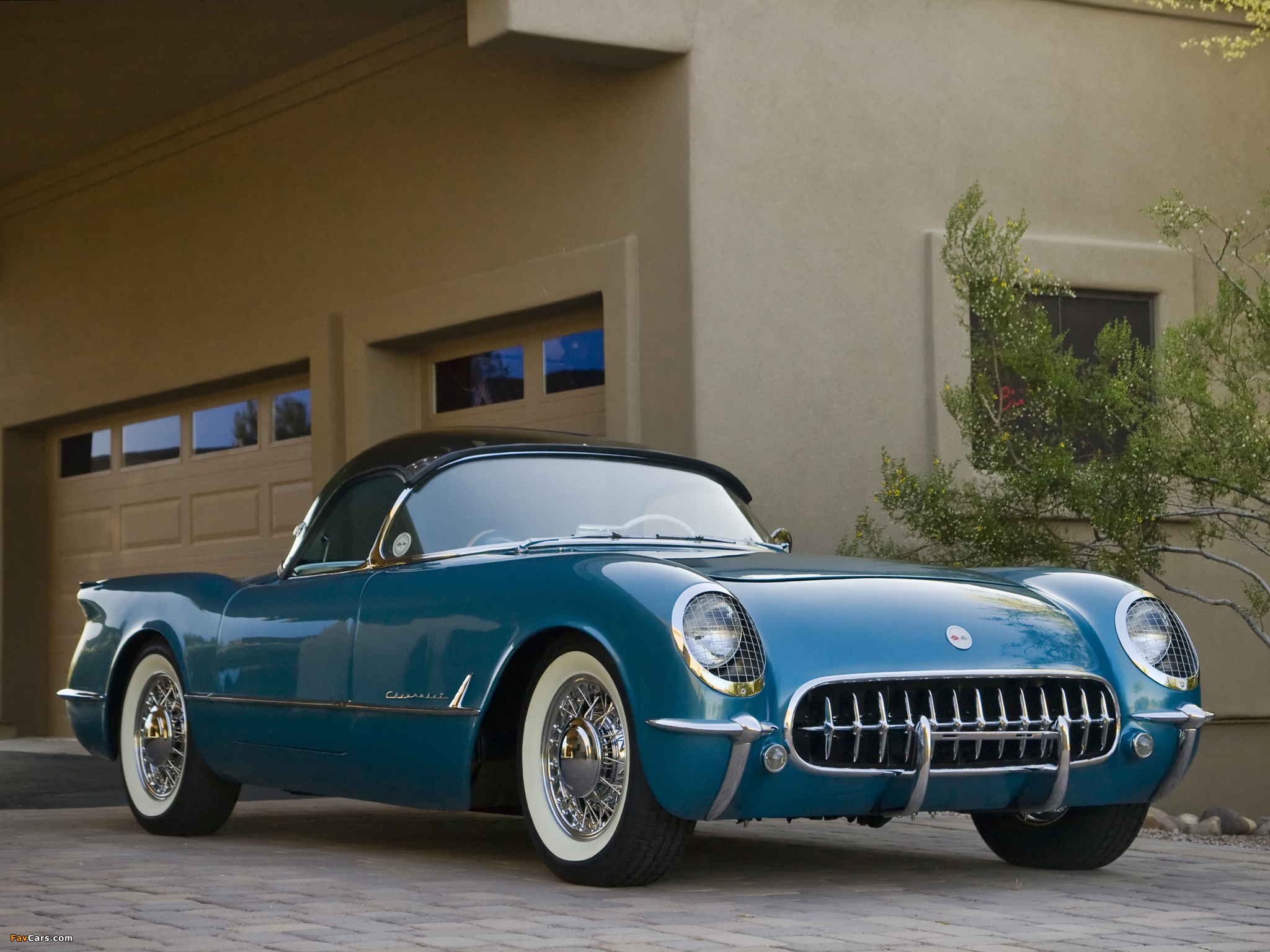
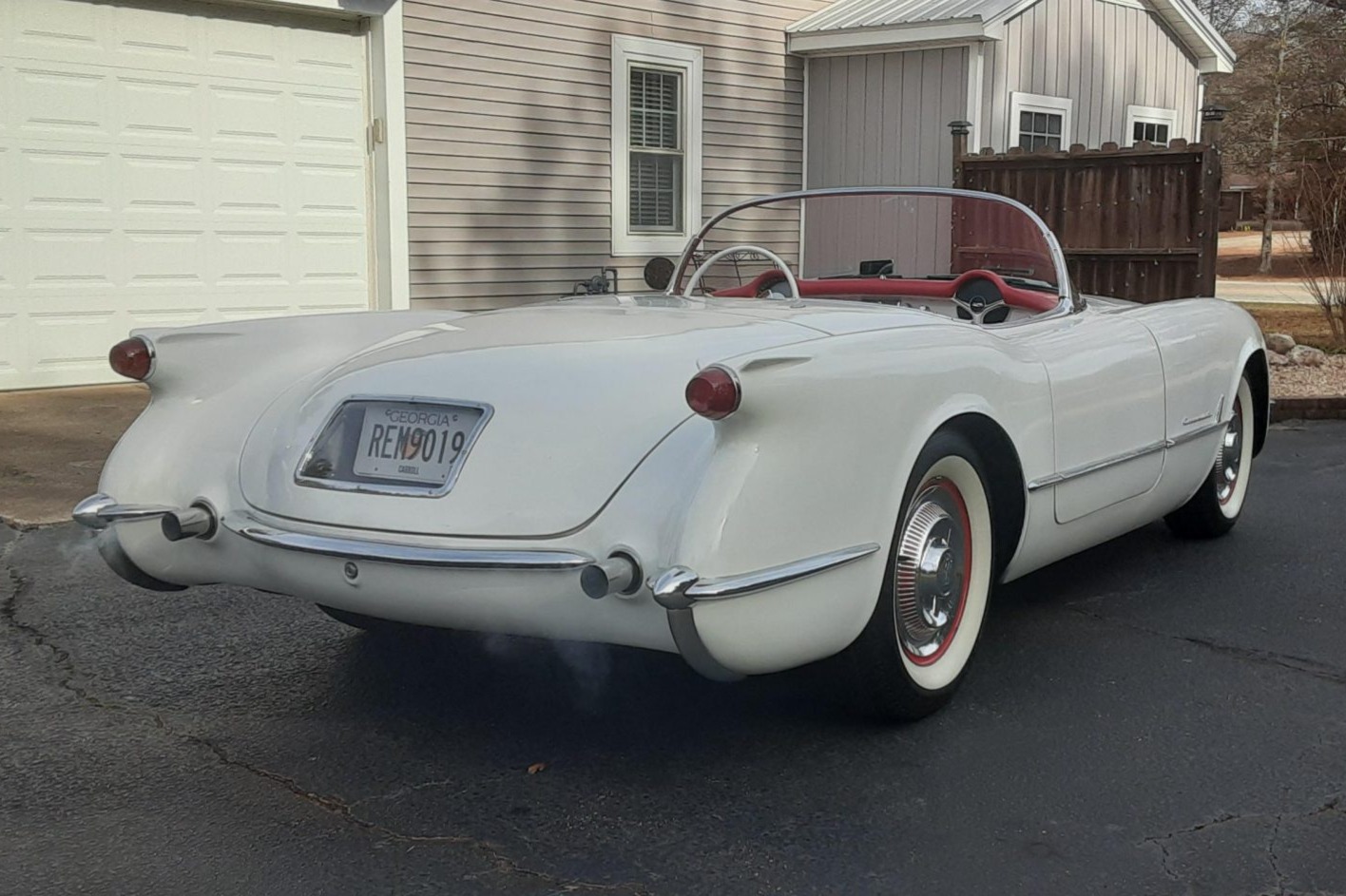
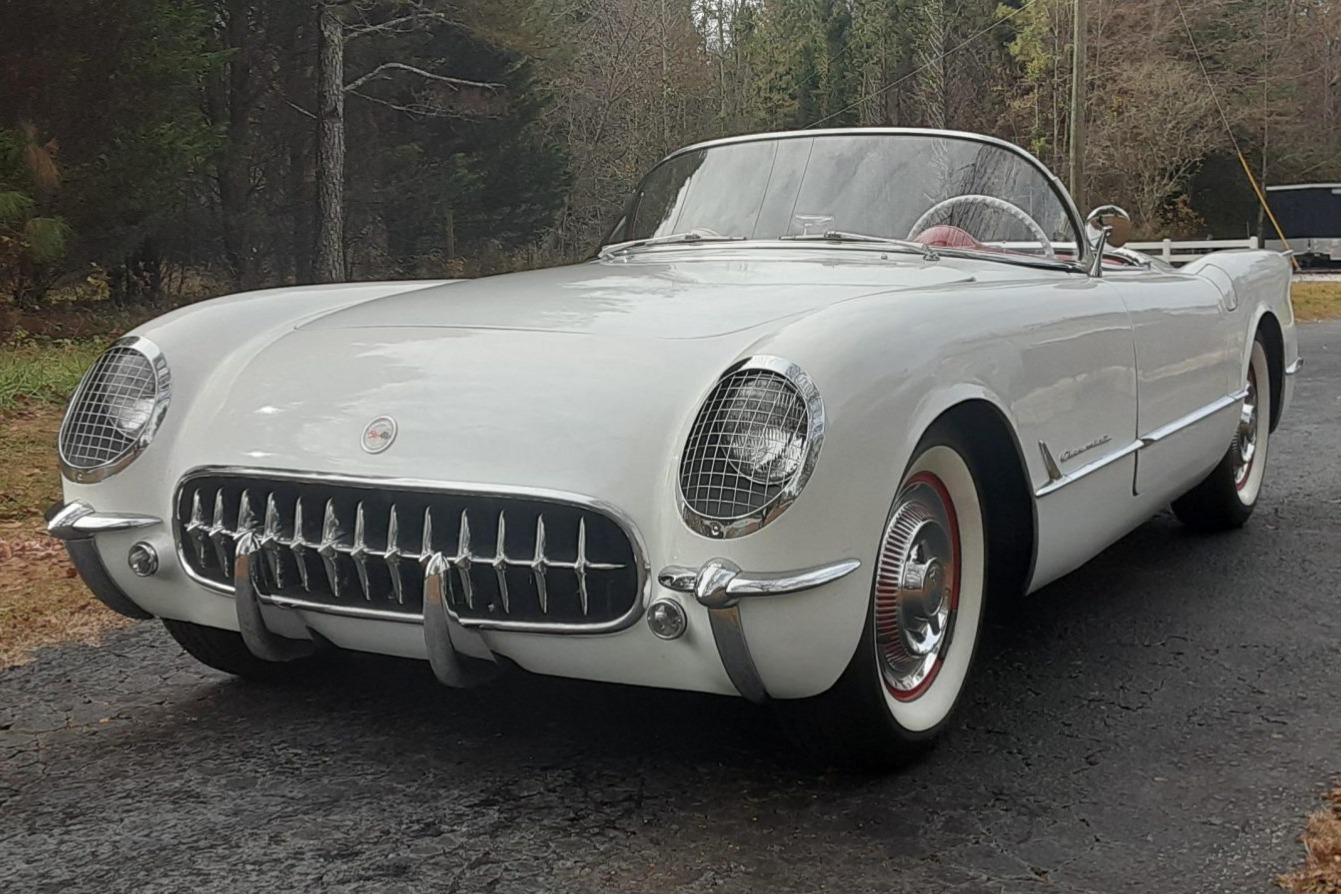
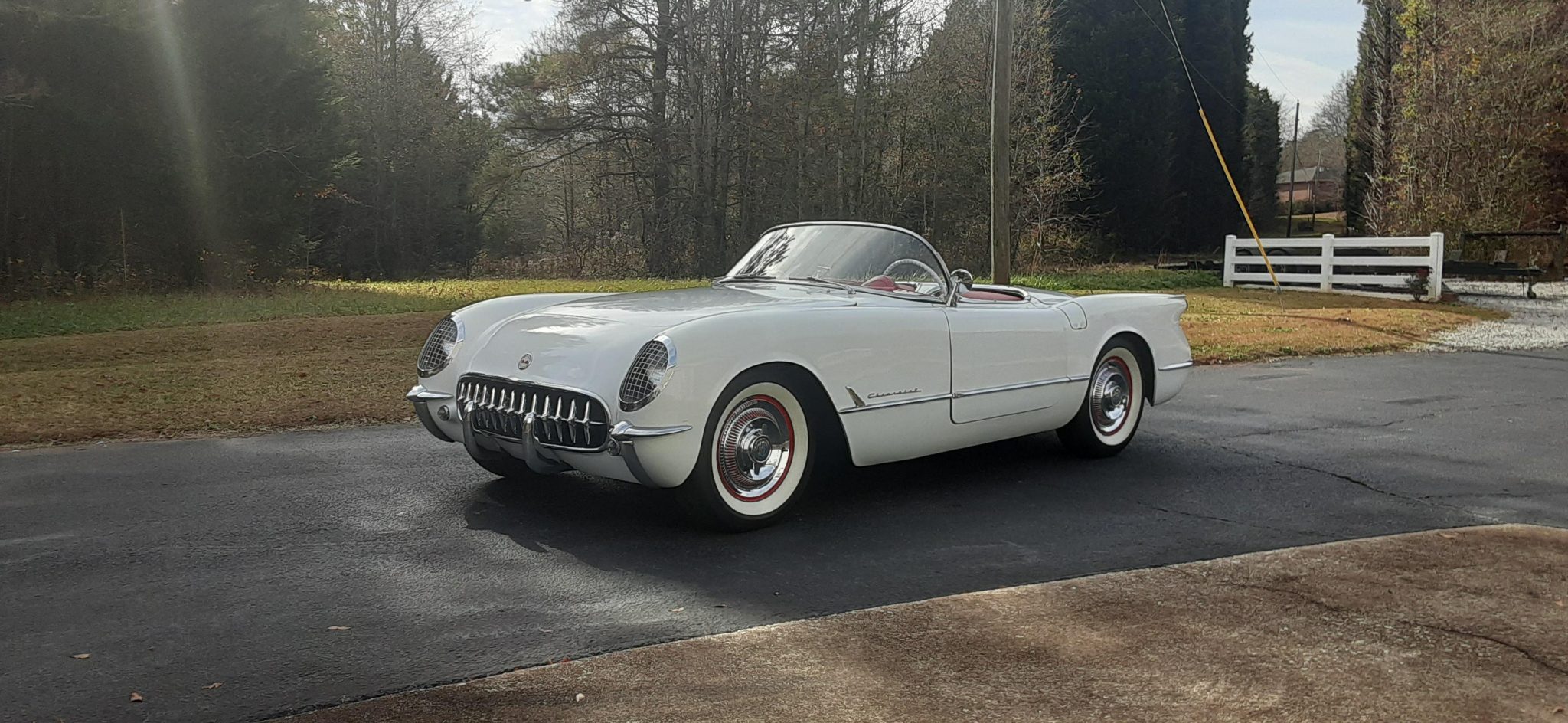

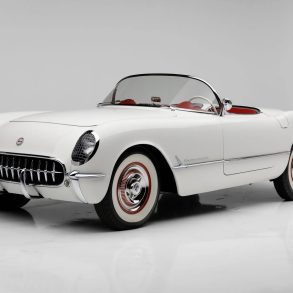
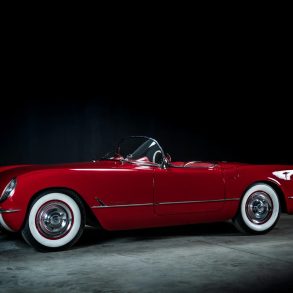
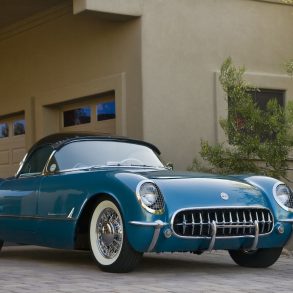
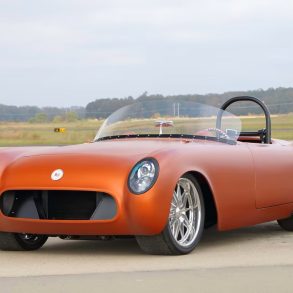

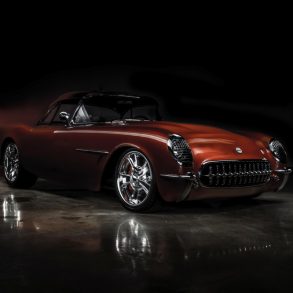
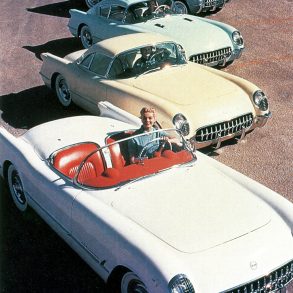

Need alignment specs, 1954 Corvette
Well Scotty boy, you certainly DO NOT KNOW ABOUT XK-120 Jaguars !!! Show me the v-8 you say they have and I’ll eat it without catsup !!!